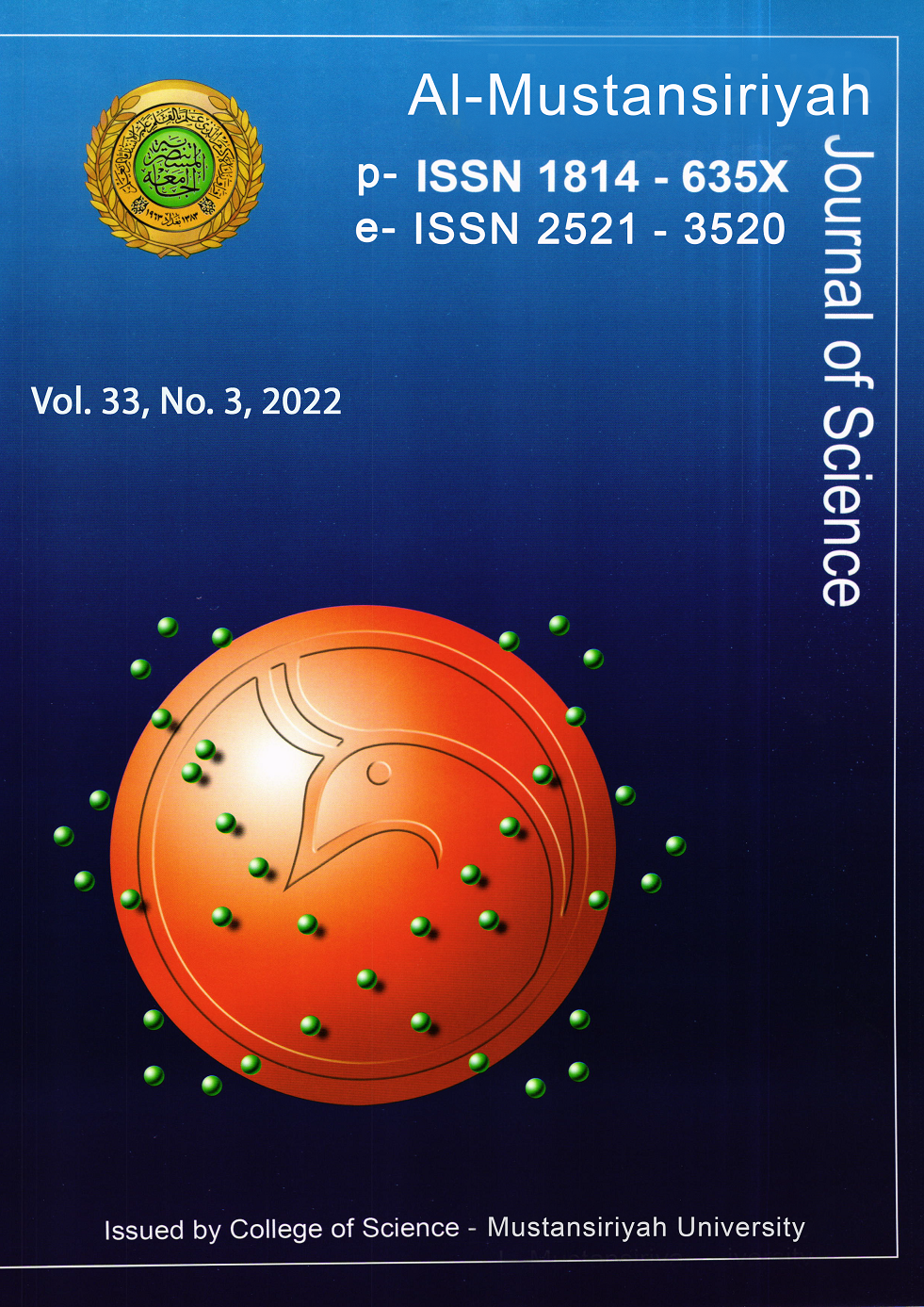The impact of Cobalt and Strontium radiation on Pseudomonas aeruginosa
DOI:
https://doi.org/10.23851/mjs.v33i3.1157Keywords:
Irradiation, radiation, bacteria, cobalt, strontiumAbstract
The research aims to study the effect of radiation emitted from different clinical sources, including cobalt and strontium. The study was carried out using isolates of Pseudomonas bacteria isolated from Baghdad hospitals during the year 2021, about 20 isolates from the blood of patients infected with the bacteria. The results showed a lethal effect on Pseudomonas bacteria when exposed to radiation at different times during one hour, two hours and three hours. Different doses using cobalt with effective 1 mci and 10 mci in the presence and absence of aluminium, and the use of strontium in the presence and absence of aluminium. Co60 (10Mci) without Alminium, with dose 12.48472106(1hr.), 24.96944212 (2hr.), 37.45416318 (3hr.) that emit Beta and Gamma; Co60 (10Mci) with aluminium with dose 0.023315312×10-7 (1hr.), 0.046630625×10-7 (2hr.), 0.069945936×10-7 (3hr.) that emit Beta ray; Co60 (1Mci) without Alminium with dose 3.4178394 (1hr.), 6.835678887 (2hr.), 10.2535182 (3hr.) that emit Beta and Gamma; Co60 (1Mci) with alminium with dose 0.155992856*10-4 (1hr.), 0.311985712*10-4 (2hr.), 0.467978568×10-4 (3hr.) that emit Beta ray and Sr90 with dose 0.73251×10-2 (1hr.) 1.4650×10-2 (2hr.), 2.19753×10-2 (3hr.) The results showed that the killing rate of P. aeruginosa bacteria using cobalt 10 mCi without aluminium was 78%, and in the presence of aluminium 100%. In comparison, the killing rate of Pseudomonas bacteria with effective effectiveness of 1 mC without aluminium was 100% and in the presence of aluminium 98%, and the killing rate of Pseudomonas bacteria without aluminium was 83% and in the presence of aluminium 96% compared with control.
Downloads
References
H. Fazeli, R. Akbari, S. Moghim, T. Narimani, M. R. Arabestani, and A. R. Ghoddousi, "Pseudomonas aeruginosa in patients, hospitals means and personnel's specimens". J. Res. Med. Vol. 17, no. 4, pp:332-3372, (2012).
Tavares, W. (2000). Bactérias gram-positivas problemas: resistência do estafilococo, do enterococo edo pneumococo aos antimicrobianos. Rev Soc Bras Med Trop. 33; (3):281-301.
Zarychanski, R.; Ariano, R.E.; Paunovic, B. and Bell, D.D. (2009). Historical perspectives in critical care medicine: blood transfusion, intravenous fluids, inotropes/vasopressors, and antibiotics. Crit Care Clin. (1):201-20.
"The Electromagnetic Spectrum". (2018). Centers for Disease Control and Prevention.
Kollef, M. H. (2013). Antibiotics for the critically ill: more than just selecting appropriate initial therapy. Crit Care. 2; 17 (3):146.
Karen, B. (2007). Cancer Sourcebook. Detroit, MI: Omnigraphics. pp. 112-113. ISBN 978-0-7808-0947-5.
International Atomic Energy Agency. (2002) The Radiological Accident in Samut Prakarn, IAEA, Vienna.
Food and agriculture organization of the United Nations, international labour organization, OECD nuclear energy agency, pan American health organization, International Basic Safety Standards for Protection against Ionizing Radiation and for the Safety of Radiation Sources, Safety Series No. 115, IAEA, Vienna (1996).
International Atomic Energy Agency. Investigation of an Accidental Exposure of Radiotherapy Patients in Panamá. IAEA, Vienna, (2001).
Collins, M.D. and Lawson, P.A. (2000). The genus A biotrophia (Kawamura et al.) is not monophiletic: proposal of Granulicatella gen. nov., Granulicatella adiacens comb.nov., Granulicatella elegans comb. nov.and Granulicatella balaenopterae comb. nov. Int. J. Syst. Evol. Microbiol. 50:365-369.
Porta, M. (2014) "A dictionary of epidemiology", 6th edn, New York: Oxford University Press. ISBN 9780199976737.
Forbes, B. A.; Sahm, D.F. and Weissfeld, A. S. (2007). Baily and Scott's Diagnostic Microbiology. 11th edition. Mosby, Inc. Baltimore, USA., 384-398.
Holt, J. G.; Krieg, N. R.; Sneath, P. H. A.; Staley, J. T. and William, S. T. (1994). Berge's Manual of Determinative Bacteriology. 9th. ed. Williams&Wilkins, USA. P.532-551.
Biomeruex corporation. (2010). VITEK, USA.
Carlton, R.M.; Noordman, W.H.; Biswas, B.; de Meester, E.D. and Loessner, M. J. (2005). Bacteriophage P100 for control of Listeria monocytogenes in foods: genome sequence, bioinformatic analyses, oral toxicity study, and application. Regul Toxicol Pharmacol 43(3):301-12.
Barros, R. R; Carvalho , G. S; Peralta, J. M.; Facklam, R. R. and Teixeira, L. M. (2001). Phenotypic and Genotypic Characterization of Pediococcus Strains Isolated from Human Clinical Sources. J. Clin. Microbiol. 39:1241-1246. 76.
Chang, Y. H.; Han, J.; Chun ,J.; Lee, K. C.; Rhee, M.S.; Kim, Y.B. and Bae, K.S. (2002). Comamonas koreensis sp.nov., is a non-motile species from a wetland in Woopo, Korea. Int. J. Syst. Evol. Microbiol., 52:377-318.
Ismail, M.C.H.; Waleed, S.; Jabbar, F. and Ibrahim, K. (2012). Effect of Diode Lazer (805) nm on alpha-toxin production and antibiotic sensitivity of Staphylococcus aureus. Iraqi J. Sci Vol 53. No. 2. Pp 755-759
SAS,(2020). Statistical Analysis System- SAS.
Mohammed, N. R.; Sabaa, H. S. and Sanaa R. (2021). Biological activity of Nd: YAG laser and Beta, Gamma radiation on Klebsiella pneumonia resistance Colistin. Sys Rev Pharm. 12 (1), 28-3.
Downloads
Key Dates
Published
Issue
Section
License
Copyright (c) 2022 Al-Mustansiriyah Journal of Science

This work is licensed under a Creative Commons Attribution-NonCommercial 4.0 International License.
(Starting May 5, 2024) Authors retain copyright and grant the journal right of first publication with the work simultaneously licensed under a Creative Commons Attribution (CC-BY) 4.0 License that allows others to share the work with an acknowledgement of the work’s authorship and initial publication in this journal.






















